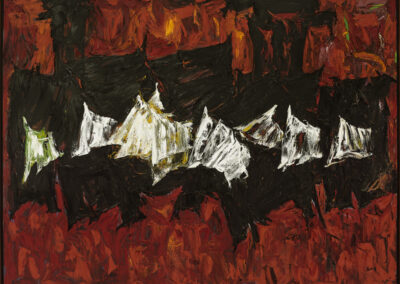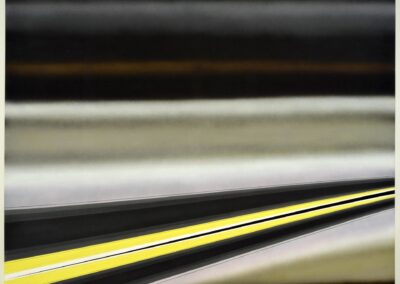Our next Artist You Need To Know is someone who briefly attended the École des Beaux-Arts in Montreal, but departed after less than two years of study. Rita Letendre declared that “the school was too academically rigid and conservative.”(from James Rottman Fine Art) Several years later, in the early 1950s, Letendre became familiar with Les Automatistes (arguably one of the most unique Canadian schools of painting, ever) and Paul-Emile Borduas and his circle were the the exact opposite of what she’d endured at the École des Beaux-Arts. She found herself very engaged by ”Borduas’ encouragement of a new sense of self-determinaton and new visual vocabulary”.(Again, from the artist’s page at Rottman Fine Art).Being from Drummondville and of both Québécois and Abenaki heritage. Letendre’s embrace of the style and ideas of Les Automatistes was indicative of her time, with the Quiet Revolution in Quebec that would change the Quebec and Canadian landscape only a few years away – especially in terms of painting and visual culture.
Letendre was as precise with words as with her brush, describing her paintings as follows: “My painting is non-figurative, abstract, maybe it’s lyrical. All the terminology is not important. What is important is the actual painting. When you’re looking at the painting you’re looking at something real, and that’s what counts.” (from the National Gallery) She is a printmaker and muralist, as well as a painter, and her artistic sphere has also intersected with the Plasticien movement in Québec. This group espoused a more ‘orderly’, or geometric approach to abstraction than Les Automatistes (and this conversation can be seen in Letendre’s own progression as a painter, as well).
The Montreal Museum of Fine Arts hosted the first of many solo exhibitions by Letendre, in 1961.Several other exhibitions of note, from her impressive history, include Rita Letendre, The Montreal Years, 1953-1963 (1989, Concordia Art Gallery, Montreal); Rita Letendre, Aux Couleurs du Jour (2003 at the Musée National des Beaux-Arts du Quebec, which traveled to the Winnipeg Art Gallery in 2005); and Rita Letendre, Beginnings in Abstraction (Robert McLaughlin Gallery, 2005). These are just a few of the many solo and group exhibitions (encompassing both public and private galleries around the world) of Letendre’s paintings.
-

Envol, 1964
-

Victoire, 1961
-

Blues...? 1980
-

Nuit d' Avril, 1962
-

Tension II, 1962 - 63
-

Sun Song, Tel-Aviv. 1969
Letendre’s paintings have moved through different phases, but always exploring the challenge of abstraction. In looking back over the decades of her artwork, sometimes a more formal ‘structured’ space is created; at other times, gesture and motion, through palette work that is alternately expressive or delicate, is the rule; sometimes patterning or thick, textured bursts of colour define her field instead. She was based in Montreal until 1962, before traveling to Paris, Rome and Israel for several years, and during this time, her work incorporated a more ‘hard edged’ approach. Her HIghway Series – which she began in the late 1960s – is considered by many to be her finest work, and ranks her among the top of Canadian painters.
Curator Timothy Long, in writing about Letendre’s work for the MacKenzie Art Gallery (Regina, Saskatchewan), offers the following about her importance: “As one of the few women artists involved in the movements of the 1950s and 1960s, Letendre offers an important voice, alongside that of her ground-breaking contemporary Françoise Sullivan. Finally, as an artist of First Nations ancestry, she created work that implements the work of other artists who have employed the language of abstraction to articulate Indigenous identities, such as Bob Boyer, Faye Heavy Shield, and Robert Houle.” Letendre has been named an officer of the Order of Canada and is a past recipient of the Governor General’s Award as well.
You can learn more about Rita Letendre’s art and ideas at several places online. A CBC video from 1969 is available here and in 2014 Franco-Ontarian Groupe Média TFO produced a documentary (available here) on the artist and her work that offers an interesting portrait of Letendre that offers a fine overview of her significant career. .












